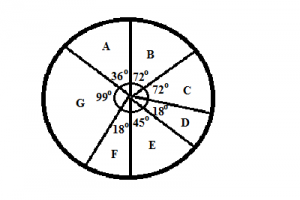Hello Aspirants. Welcome to Online Quant Section in AffairsCloud.com. We are starting IBPS Clerk course 2015 and we are creating sample questions in Quantitative Aptitude section, type of which will be asked in IBPS Clerk Prelims Exam.
Stratus – IBPS Clerk Course 2015

[flipclock]
Directions (1-5): Study the pie chart below which gives the distribution of the number of students in different sections of class 10 in a school. Answer the questions that follow.
- Which of the following combination of sections contribute to 50% of the total strength of class 10?
A) A, B, F
B) B, C, F
C) A, B, C
D) C, D, E
E) None of theseC) A, B, C
Explanation:
A, B, F = 36o+72o+18o = 126o
B, C, F = 72o+72o+18o = 162o
A, B, C = 36o+72o+72o = 180o
C, D, E = 72o+18o+45o = 135o
180o is the half of complete 360o, so sections A, B, and C contribute to 50% of total strength. - If there are 144 students in section A, then what is the number of students in section G?
A) 396
B) 108
C) 325
D) 366
E) None of theseA) 396
Explanation:
Let total number of students in class 10 is x
So (36/360) * x = 144
This gives x = 1440
So number of students in section G = (99/360) * 1440 = 396 - If the number of students in section B is 50% more than that in section A, then number of students in section A is what percent less than that in section B?
A) 16 2/3%
B) 25%
C) 33 1/3%
D) 40%
E) 50%C) 33 1/3%
Explanation:
There is no need to see the pie chart to answer this question
Required % = 50/(100+50) * 100 - Find the number of students in sections A, B and E together.
A) 644
B) 524
C) 500
D) Cannot be determined
E) None of theseD) Cannot be determined
Explanation:
Number of students in section A = 36/360 * (total number of students in class 10)
Since we are not given the total number of students in class 10, we cannot determine the number of students in each section. - If the total number of students of class 10 increase by 50% and students in section A increase by 20%, then what will be the angle for section A in the new pie-chart?
A) 35.8o
B) 25.5o
C) 36.4o
D) 28.8o
E) None of theseD) 28.8o
Explanation:
Let total students in class 10 is ‘s’. After increase by 50%, new number of students = 150/100 * s = 3s/2
Angle for section A is 36o, so students in section A = 36/360 * s = s/10. They increase by 20%, so new number of students in section A = 120/100 * s/10 = 6s/50
So new angle for A = [(6s/50)/(3s/2)] * 360 = 28.8o - A jar contains 4 green balls, 4 white balls and 4 yellow balls. If 3 balls are drawn at random, find the probability that the balls are not of the same color.
A) 44/57
B) 52/55
C) 3/55
D) 10/31
E) None of theseB) 52/55
Explanation:
The probability can be found by subtracting prob. that all balls are same in color from 1.
Total ways of drawing 3 balls out of total 12 balls = 12C3 = 220
Case 1: all balls green
Ways are 4C3 = 4
Case 2: all balls white
Ways are 4C3 = 4
Case 3: all balls yellow
Ways are 4C3 = 4
So prob. that all balls are of same color = (4+4+4)/220 = 12/220 = 3/55
Prob. that they are not of same color = 1 – 3/55 = 52/55 - A, B and C start a business in which A’s contribution is 3/2 times that of B’s and also A’s contribution is thrice that of C’s. Their total investment in the business is Rs 15,000. Find the share of B in the profit of Rs 3000 at the end of a year.
A) Rs 2,000
B) Rs 1,500
C) Rs 1,050
D) Rs 1,000
E) Rs 500D) Rs 1,000
Explanation:
Let A’s contribution = Rs x, then B’s contribution = 2/3 * x and C’s contribution = 1/3 * x
Then profits in the ratio –
A : B : C = x : 2x/3 : x/3 = 3 : 2 : 1
So share of B = [2/(3+2+1)] * 3000 = 1000 - A, B and C together can complete a piece of work in 4 days. All started the work and after working for 2 days, B left. A and C completed the remaining work in 3 days. Find the number of days in which B can alone complete the work.
A) 10 days
B) 12 days
C) 15 days
D) 18 days
E) 21 daysB) 12 days
Explanation:
(A+B+C)’s 1 day’s work = 1/4
They work for 2 days. So work done after 2 days = 1/4 * 2 = 1/2
Now B left, so remaining work (1 – 1/2) = 1/2 is to be done by A and C in 3 days.
1/2 work done in 3 days so complete (1) work done by A and C in 6 days.
Now (A+B+C)’s 1 day’s work = 1/4 and (A+C)’s 1 day’s work = 1/6
So B’s 1 day’s work = 1/4 – 1/6 = (3-2)/12 = 1/12 - The amount that A and B earns is in the ratio 4 : 5. If income of A is increased by 25% and that of B is decreased by 20%, the ratio of their earnings becomes 5 : 4. Find the total of their earnings.
A) Rs 75,000
B) Rs 55,000
C) Rs 50,000
D) Data inadequate
E) None of theseD) Data inadequate
Explanation:
Let A’s income = 4x, B’s income = 5x
After change – A’s income = 125/100 * 4x = 5x and B’s income = 80/100 * 5x = 4x
So new ratio = 5x : 4x = 5 : 4 which is also given, but it does not give value for x, so data inadequate - There is a loss of 25% on an article when it is sold at 2/5 of its Marked Price. How much percent more is Marked Price than Cost Price?
A) 80.5%
B) 82%
C) 87.5%
D) 89.25%
E) None of theseC) 87.5%
Explanation:
Let MP = x
Then SP = 2/5 * x = 2x/5
Loss is 25%, so CP = [100/(100-25%)] * 2x/5 = 8x/15
So required % = [(x – 8x/15)/(8x/15)] * 100
= [(7x/15) / (8x/15)] * 100 = (7/8) * 100 = 87.5%
AffairsCloud Recommends Oliveboard Mock Test
AffairsCloud Ebook - Support Us to Grow
Govt Jobs by Category
Bank Jobs Notification


